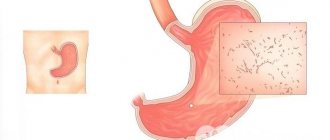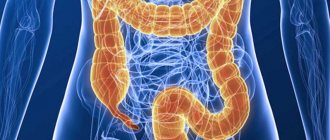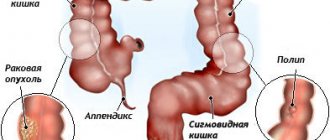Causes of pneumatosis intestinalis
The main reason for the development of pneumatosis is disturbances in the digestive system , resulting in increased accumulation of gases.
The appearance of the disease is influenced by the following factors:
- if in childhood the child suffered serious intoxication of the body;
- if there is severe hypotension of intestinal peristalsis, which causes a strong accumulation of gases in the colon area;
- if there are strong spasms in the intestines that do not allow gases to escape on their own. This subsequently leads to the formation of cysts;
- any intestinal obstruction;
- food poisoning;
- eating disorders provoke pneumatosis;
- infectious diseases of the large and small intestines;
- adhesions in the intestines;
- hernias in the intestines;
- intestinal injury;
- colitis;
- appendicitis;
- pancreatic diseases;
- pregnancy;
- liver diseases;
- if there are tumors and polyps in the anal area that do not allow gases to escape, pneumatosis may appear.
Causes
- early childhood, when the innervation of the intestines and the digestive process are imperfect;
- old age, when there is enzymatic deficiency and decreased motor skills;
- intestinal infections - dysentery, salmonellosis, toxic damage when pathogenic bacteria produce a lot of gas;
- benign and malignant tumors, when the neoplasm blocks the lumen and gases penetrate into the intestinal wall;
- impaired motility due to inflammation, congenital defects (Crohn's disease or chronic inflammation of all layers of the intestine), adhesive disease, when the “stagnation” of a food bolus causes local swelling of the wall;
- violation of the natural removal of gases due to diseases of the rectum and anal ring - polyps, tumors;
- repeated stress causing intestinal spasms;
- low physical activity, which impairs motor skills;
- unhealthy diet with consumption of large amounts of foods that cause increased gas formation;
- bronchial asthma and obstructive pulmonary diseases - prolonged persistent cough causes emphysema of the mediastinum, as a result of which air enters the peritoneum, from where it penetrates the intestinal wall.
Symptoms
Having identified symptoms, treatment is carried out only according to the doctor’s indications. Depending on the age and neglect of pneumatosis, the disease can manifest itself in different ways.
The most characteristic signs are:
- feeling of heaviness and fullness in the intestines;
- when diagnosed, bags of gases resemble bunches of grapes;
- the patient experiences increased gas formation;
- a person is bothered by painful sensations in the abdomen in the form of colic;
- pain can be constant or paroxysmal;
- there is frequent constipation;
- intestinal obstruction may occur;
- a cyst in children resembles a cluster of small air bubbles;
- feeling of discomfort in the abdominal cavity;
- nausea or vomiting;
- In places where gases are localized, bloating is observed. This is especially evident in newborns;
- constant belching of air;
- pain in the spleen area;
- cyanosis of the skin;
- general malaise;
- decrease in pressure;
- intestinal pneumatization;
- Complications may include shock or loss of consciousness.
Another article on this topic: Why does my stomach growl after eating? Causes and treatment
Classification and types
The classification of pneumatosis allows you to accurately determine the clinical picture, determine the diagnosis and its possible complications. The separation of types of pneumatosis helps to determine the tactics of treating the disease.
By nature of occurrence
There are two types of pneumatosis based on the type of occurrence:
- primary process;
- secondary pneumatosis.
Primary pneumatosis of the stomach develops against the background of persistent functional disorders of the gastrointestinal tract, with mental illness (psychosis, hysteria, neurasthenia). The primary process is often associated with increased emotional and nervous stress, with disruptions in nervous activity. The combination of pneumatosis and autonomic disorders is explained by regular irritation of nerve endings in the cavities of the gastrointestinal tract. The secondary process develops with existing pathologies of the gastrointestinal tract, persistent mental disorders as a complication of underlying diseases.
According to the nature of the flow
The clinical picture of aerophagia appears in accordance with the condition that caused the pathology. Based on the type of course, the following types of pneumatoses are distinguished:
- neurological (swallowing air through the mouth during seizures, hysteria, psychosis);
- organic (swallowing of air due to the abnormal structure of the gastrointestinal tract, swallowing a large amount of air when eating).
Important! Functional aerophagia of newborns also occurs. Regurgitation (otherwise, physiological regurgitation of fresh milk mass) occurs as a result of underdevelopment of the digestive system. Against the background of the baby’s absolute health, belching and regurgitation are transient in nature, and the condition itself is more relevant to general pediatric practice.
Diagnosis of pneumatosis intestinalis
Most often, patients come to the doctor with complaints of ailments and problems with the gastrointestinal tract. And only after diagnostic measures, intestinal pneumatosis is detected in a person. The doctor can already determine the accumulation of gases by palpation if the patient has hyperpneumatosis. When pressing on the abdominal cavity, you can hear gas bubbles begin to burst in the abdomen.
But in order to establish an accurate diagnosis and determine pneumatosis, it is necessary to undergo a number of diagnostic procedures:
- X-ray;
- colonoscopy, which examines the intestinal cavity for the presence of cysts;
- endoscopy, which allows not only to establish the correct diagnosis and assess the condition of the intestinal mucosa, but also to take material for a biopsy to exclude or confirm the presence of malignant formations.
Untimely diagnosis and treatment of intestinal pneumatization can lead to serious complications. Therefore, only a doctor decides how to treat pneumatosis and what methods need to be used for the disease.
Diagnostic methods
Diagnosis is necessary to confirm the presence of an abnormality and determine how to treat pneumatosis intestinalis. The patient is given a referral to:
- Ultrasound;
- radiography;
- endoscopy.
Additional diagnostic methods may be recommended. Intestinal pneumatosis is most easily determined by ultrasound. The doctor confirms the accumulation of gaseous substances of various etiologies.
Pathology can be confirmed by radiography of the abdominal cavity and gastrointestinal tract. Diagnosis is carried out on an empty stomach. A few days before the procedure, the patient should exclude from the diet:
- beans;
- raw vegetables;
- milk;
- fatty and fried foods.
X-ray of the intestines is one of the diagnostic methods for suspected cystosis.
All of the listed foods contribute to increased gas formation. This can make the diagnostic process difficult. At the same time, radiography is not an effective method in the early stages of deviation. This method will not help establish the diagnosis of “severe pneumatosis intestinalis”.
Palpation of the intestine is required. The doctor can tactilely detect new growths with air. However, thanks to this, only a primary diagnosis can be established. Thanks to endoscopy, the doctor assesses the size of the tumors and the extent of the lesion.
Complications of pneumatosis intestinalis
If not treated in a timely manner, pneumatosis intestinalis causes severe complications, which can be fatal in advanced cases. Most often, with advanced hyperpneumatization, the following may develop:
- complete or partial intestinal obstruction;
- clogging of the intestinal lumen with cysts;
- the formation of a loop of the stomach, when one part of it bends under the other;
- intensive adhesive process;
- colonic necrosis of the mucous membrane, which leads to circulatory problems.
Complications of pneumatosis can cause a person to lose consciousness and go into shock. Often, at an advanced stage of pneumatosis, the intestinal walls rupture, resulting in peritonitis. If surgery is not performed in a timely manner, death is possible.
What is elevated pneumatosis
Increased pneumatization of the intestine occurs due to injury to the membrane of the large and small intestine. The walls become thinner, opening the way for gases and air. Cysts or cavities appear inside the membrane, which are accompanied by symptoms and threaten complications. If you look at the intestines from the inside, the walls will be covered with bubbles. Among the types of pathological syndrome there are: widespread to the intestines, limited, pneumatosis of the colon, ileum, ileocecal region (an area of abundant proliferation of microorganisms).
Severe pneumatosis intestinalis
Single blisters formed during inflammatory processes in the gastrointestinal tract are not so terrible, but if all the walls suffer the same fate, then blockage of the intestinal lumen may occur. This painful condition is called “hyperpneumatosis” and is a severe stage of pneumatosis, when inflammation of the organ occurs along with the general symptoms of diverticulosis. Hyperpneumatization of the intestine occurs with intestinal obstruction syndrome. The process is characterized by impaired motility of this organ and problems with the passage of food through the digestive tract.
Treatment
Pneumatosis is provoked by improper functioning of the gastrointestinal tract. Therefore, treatment is aimed at combating the causes of the disease. Only in advanced stages, when the patient has severe pneumatosis and intestinal obstruction, is surgical intervention resorted to.
In other cases of pneumatosis, the doctor selects drug treatment.
Carminatives are aimed at eliminating flatulence and gas accumulation. They restore microflora and quickly remove bloating. The drugs also relieve heaviness in the stomach and relieve heartburn. The most effective are:
- Bebinos;
- Benegast Redugas;
- Espumisan;
- Colikid;
- Meteospasmil;
- Gerbeon drops.
Another article on this topic: How does the human intestine work? Where is the human intestine located?
Antispasmodics - these medications relieve intestinal spasms. The following drugs are recommended:
- Motillium;
- Motizhekt;
- Mezim Forte.
Sorbents
Recommended products:
- Activated carbon;
- Polysorb;
- Filtrum.
Enzyme preparations are medications for normalizing digestion. Such drugs include:
- Pancreatin;
- Festal;
- Somilaza.
Probiotics - improve intestinal microflora, neutralize the effects of poisons and toxins. Recommended drugs:
- Linux;
- Bifidiumbacterin;
- Lactobacillus
Antidiarrheals - prescribed to patients who experience regular diarrhea due to pneumatosis. These are medications such as:
- Stopdiar;
- Filtrum;
- Alpha Normix.
Laxatives - medications are prescribed for regular constipation. The best are:
- Slabicap;
- Weak;
- Glycerol;
- Lakitol;
- Lavacol.
Features of the pathology
Pneumatosis is characterized by an increased concentration of air masses in the gastric and intestinal cavities. The difference between pneumatosis and typical increased gas formation is the presence of cystic fragments that form between the layers of tissue of the walls of the intestine and stomach. Cystic structures can be visualized on ultrasound even in infants if there have been intestinal infections and other diseases of the gastrointestinal tract. The gas formed during pneumatosis is produced by microorganisms of the abdominal cavity.
Gastroanatomy (stomach and intestines)
Clinicians call pneumatosis aerophagia (abnormal swallowing of air). The composition of the gas contains impurities of digestion products and enzymes. The bacterial environment of the peritoneum also includes Escherichia coli. The disease can be either local or generalized, when the disease spreads to several parts of the digestive tract. When palpating the abdominal and iliac regions, they even feel the sound of gas bubbles collapsing. An endoscopic examination clearly shows the filling of the entire free space of the cavities of the epigastric organs with gas bubbles. Some blisters contain bloody spots.
Important! Frequent belching is a characteristic signal of the development of pathology of the abdominal organs. In case of systematic discomfort, it is important to immediately seek help from specialists. Self-suppression of the condition is only temporary and over time can only intensify the unpleasant sensations.
Traditional medicine
Pneumatosis can be treated with folk remedies. The most effective are the following decoctions:
- Dill water, which is prepared from a tablespoon of dill seeds diluted with a glass of boiling water. Drink this decoction up to 3-5 times a day in small sips.
- Fennel decoction is prepared in a similar way. They drink it one tablespoon three times a day.
- An infusion of wormwood is prepared as follows: a small pinch of herb is poured into a glass of boiling water, left for 5 minutes, filtered and drunk a teaspoon three times a day.
Traditional methods of treatment
Diseases of the gastrointestinal tract are described in numerous traditional medicine recipes. To reduce pain and colic, decoctions of peppermint, fennel seeds or dill are suitable. To sanitize the intestines, you can systematically drink a decoction of chamomile, lemon balm, and string in the form of regular tea. Decoctions of fruits, rose hips, plums or apples will help strengthen intestinal motility and improve the overall tone of the stomach. It is worth considering that monotherapy, consisting only of grandmother’s recipes, will not be suitable for eliminating pathology. Traditional methods will be effective when taking medications, as well as after surgery to speed up rehabilitation.
Important! The disease is dangerous due to the development of serious complications that can lead to disability or death. Any treatment must be coordinated with your doctor. Self-medication in this case can only do harm, because some drugs only temporarily eliminate symptoms, and the disease, meanwhile, progresses.
Reviews
Before starting treatment, many patients carefully study the instructions for medications and search for positive reviews on them on the Internet.
Alexander, 66 years old I suffered from gas and flatulence for a long time and did not attach any importance to my condition until I went to see a doctor for examination. I was diagnosed with pneumatosis intestinalis. A course of various medications was prescribed. The treatment did not give positive results until I started taking Bebinos. After just a few days of taking the medicine, my condition improved, I began to feel lightness, energy, and the discomfort in my stomach went away.
Elena 27 years old I was constantly tormented by colic and gas. After diagnosis, it turned out that I have pneumatosis intestinalis. I took a course of prescribed medications, but my condition was only satisfactory. After reading information about Bifidiobacterin on the Internet, I decided to drink it. The intestinal problems are completely gone. Abdominal bloating, frequent constipation, and pain are gone. And most importantly, this drug is safe and is recommended for use even by infants.
Igor, 50 years old, Bebinos helped me with intestinal pneumotosis. The positive effect was not long in coming. The discomfort in my stomach is gone. I felt lightness, a surge of strength. It’s so good when the gastrointestinal tract functions well and all negative symptoms disappear. I'm glad that there is such a drug as Bebinos.
Prevention
Preventive measures include timely detection and treatment of intestinal diseases. In this regard, you need to be examined at least 2 times during the year and, if the disease is detected, undergo the entire course of treatment.
Pneumatosis intestinalis has nonspecific symptoms and is difficult to diagnose. But if signs of such a disease are detected, you must immediately consult a doctor and not self-medicate. You should be treated with traditional medicine after visiting a specialized specialist.
Pneumatosis is very rare, so it is important to listen to your body and not let it go to the last resort. Only timely treatment will allow you to forget about the disease!
Classification
According to the prevalence of gas cysts
Depending on the prevalence of gas cysts, two forms are distinguished:
The limited form is more common when the small intestine is involved, namely the ileum and ileocecal angle or the junction of the ileum and the cecum, equipped with a valve (bauginian valve). The anatomical features of this section - a sharp bend, a valve, different microflora of the small and large intestine - create the preconditions for many disorders. Normally, the contents of the intestine move only in one direction - from the small to the large intestine, and the valve does not allow reverse movement. Diseases disrupt this balance, and gas cysts develop here easily.
By the number of gas cysts
By quantity, single and multiple gas cysts are distinguished. Multiple are more common; in appearance they resemble a bunch of grapes.
From a practical point of view, it is important how far the gas cyst protrudes into the intestinal lumen. If there is enough space left for food to pass through, then the matter is limited to discomfort and upset stool.
In the case when the cysts completely block the lumen, intestinal obstruction occurs. The swollen loops can be pressed into each other, with one section penetrating into the lumen of the other. This phenomenon is called intussusception. This leads to intestinal volvulus, necrosis of part due to impaired blood flow. Only surgical treatment can help.
Intestinal obstruction due to pneumatosis can lead to peritonitis if, under gas pressure, the intestinal wall bursts and the contents enter the abdominal cavity. Peritonitis begins, an inflammation of the peritoneum that threatens life. Treatment of peritonitis is surgical; the recovery period takes up to six months; the result is adhesive disease.
Local manifestations (at the gastrointestinal tract level)
- Flatulence or excess accumulation of gases. Normally, the intestines contain about 200 ml of gases, consisting of swallowed air, formed in the lumen of the intestines and coming from the blood. During fermentation processes, lack of enzymes and diseases, more than 2.5 liters of gases can be formed. Intestinal gas is foam covered with viscous mucus. The abundance of this foam disrupts digestion, absorption of nutrients and the concentration of enzymes. Flatulence manifests itself as discomfort, a feeling of fullness and pain in the abdomen, and increased gas production.
- Cramping pain occurs during peristaltic waves, when the swollen loops cannot consistently contract. Intestinal colic is more typical for infants and develops in the late afternoon. The baby is worried, cries hysterically, draws in his legs, and his stomach becomes hard to the touch. This continues until defecation, and after the release of feces it stops. In adults, pain is without clear localization, spreads around the navel, radiates to the epigastric and hypogastric region.
- Bowel disorders occur in people of all ages, with constipation alternating with diarrhea. Defecation brings temporary relief, then the symptoms return again.
- Heaviness in the abdomen, airy belching, pain along the intestines, loss of appetite are caused by irritation of the walls.
- Nausea, possible vomiting with severe pain. Dyspepsia is associated with disruption of the small intestine and stomach due to the formation of cysts.
General manifestations (at the level of the whole organism)
Diffuse spread of pneumatosis leads to the appearance of general symptoms:
- severe weakness;
- pale skin;
- cold sweat;
- increased heart rate;
- decrease in blood pressure.
Such symptoms are observed against the background of abdominal pain and dyspeptic disorders. Urgent consultation with a doctor is required.
If left untreated, the pain will subside after some time, and this is a very bad sign. This means that the nerve endings of the intestinal wall have died. Then peristalsis subsides, and the stage of toxic shock begins. Without surgical treatment, further life is impossible.
- early childhood, when the innervation of the intestines and the digestive process are imperfect;
- old age, when there is enzymatic deficiency and decreased motor skills;
- intestinal infections - dysentery, salmonellosis, toxic damage when pathogenic bacteria produce a lot of gas;
- benign and malignant tumors, when the neoplasm blocks the lumen and gases penetrate into the intestinal wall;
- impaired motility due to inflammation, congenital defects (Crohn's disease or chronic inflammation of all layers of the intestine), adhesive disease, when the “stagnation” of a food bolus causes local swelling of the wall;
- violation of the natural removal of gases due to diseases of the rectum and anal ring - polyps, tumors;
- repeated stress causing intestinal spasms;
- low physical activity, which impairs motor skills;
- unhealthy diet with consumption of large amounts of foods that cause increased gas formation;
- bronchial asthma and obstructive pulmonary diseases - prolonged persistent cough causes emphysema of the mediastinum, as a result of which air enters the peritoneum, from where it penetrates the intestinal wall.
Intestinal pneumatosis is not an independent disease, but develops as a complication of other diseases. Therefore, therapeutic activity is aimed at eliminating the underlying disorder. If it is possible to suppress the infection, remove spasms and restore motility, then the intestinal bloating also stops.
Treatment consists of diet, medications, hyperbaric oxygen therapy if necessary, and surgery.
Food should be gentle, warm, boiled and preferably pureed or chopped. Portions are small, no more than a glass at a time. You need to eat often, 4-5 times a day with short breaks. It is required to consume a sufficient amount of liquid, and prepare food from permitted products.
- pureed vegetable soups;
- soups with secondary meat and fish broth;
- porridge, except pearl barley and barley;
- boiled lean poultry;
- boiled lean fish;
- weak unsweetened tea;
- natural fruit drinks;
- non-sour jelly.
- legumes;
- tomatoes;
- all types of cabbage;
- apples;
- canned food;
- fried and smoked;
- fresh hot bread;
- baked goods;
- carbonated drinks.
Medicines
The choice of medications is dictated by the underlying disease; in case of an infectious nature, antibiotics of different groups are used.
To eliminate the symptoms of pneumatosis, the following medications are used:
- carminative, based on dill (fennel) – dill water, Plantex;
- based on simethicone - Bobotik, Espumisan, Sab Simplex;
- antispasmodics - drugs based on the substances drotaverine, bencyclane, papaverine, bendazole;
- laxatives – sodium sulfate, Carlsbad salt, Lactulose, Duphalac, Inulin, Normaze, Prelax;
- anti-diarrhea drugs - Nifuroxazide, Enterofuril, Fthalazol, Furazolidone;
- enterosorbents – activated carbon, Enterosorbent, Polyphepan, Smecta, Polysorb;
- prokinetics for motility disorders - Bromoprid, Domperidone, Metoclopramide.
Hyperbaric oxygenation
HBOT is a treatment with an air mixture with a high oxygen content in a pressure chamber. The method eliminates oxygen starvation of tissues, stops the development of pathogenic bacteria (especially staphylococci), and improves immune status. The most important effect is an increase in the viability of the intestinal wall and acceleration of metabolism.
Under the influence of HBOT, microcracks are quickly healed and gas bubbles are accelerated.
Surgery
It is used as a last resort if intestinal obstruction, peritonitis or a tumor has developed.
Endoscopic techniques are rarely used, only for small benign tumors. In other cases, wide access is used, the abdominal cavity is opened, and a thorough inspection of all organs is performed. Tumors, diverticula, intussusceptions, and dead areas of the intestine are removed. Drains are installed and removed after the inflammation subsides. Rehabilitation after surgical treatment takes up to a year.
Depends on the underlying disease that caused pneumatosis. In children of the first year of life, the prognosis is always favorable, since the digestive system becomes more perfect every day. After reaching 6 months of age, intestinal colic caused by pneumatosis begins to decline.
In old age, it is enough to streamline your diet and slightly increase physical activity for the condition to improve.
The most dangerous is pneumatosis, caused by a tumor and infection. Cases of obstruction and peritonitis due to isolated pneumatosis are extremely rare. Treatment of relevant diseases is carried out before complications occur.
General information about the disease
Intestinal hyperpneumatosis is a fairly rare disease of the digestive system, in which gases penetrate from the intestinal cavity into the thickness of its walls and form air cavities in them. In most cases, this pathological process is localized in the subserous or submucosal layer of the jejunum or colon. The disease can occur in people of all ages, but mainly occurs in older people and infants due to frequent disturbances of the digestive system and reduced physical activity.
The size of air cysts in diameter varies from 0.5 to 5 cm. According to the prevalence of the process, hyperpneumatosis is divided into diffuse and limited, which affects only one area of the intestine. The diffuse form is characterized by the uniform distribution of pathological formations along the entire length of the intestinal tract.
Frequently asked questions from patients: “Does intestinal hyperpneumatosis occur without structural changes?”, “How to treat the disease?”. The disease never goes away without structural changes, since air cysts disrupt the structure of the intestinal walls, after which more serious organic lesions can develop.
Accurate diagnosis
Pathology can be detected in the following ways:
p, blockquote 17,0,0,0,0 —>
- The best visualization of the organs involved in the disease process is achieved using x-rays.
- Ultrasound is another effective diagnostic method.
- Colonoscopy is an examination of the mucous membrane to detect its defects.
- Sometimes a qualified surgeon can detect the presence of cysts by palpating if they are large enough.
After the examination, a rectal biopsy is performed (tissue collection for analysis).
p, blockquote 18,0,0,0,0 —>
What is allowed?
Because of the list of restrictions listed above, you may get the impression that you can’t eat anything at all. In fact, this is not so - the variety of foods and dishes allowed and even recommended for intestinal motility disorders is great.
Cereal porridges boiled in water are extremely useful:
It is recommended to either steam or cook any food before eating. You can simmer. But you shouldn't eat fried food. Only those flour products that were made from coarsely ground raw materials can be eaten.
To achieve the maximum positive effect from the diet, you need to eat strictly according to the schedule. This regimen will help normalize the production of gases in the intestines and improve the health of the body. You should eat small portions, but at least six times a day.
Eat slowly, chewing all food thoroughly. Remember that when talking while eating, a person involuntarily swallows air, which only aggravates the situation. It is recommended to eat at the same time every day.
Treatment of pneumatosis
Usually, pneumatosis is considered as a secondary process, therefore, treatment is mainly carried out for those diseases and conditions that caused damage to the intestinal wall.
First of all, this is the treatment of intestinal infections in young children with intestinal antiseptics and rational antibiotics based on culture results.
With the development of intestinal obstruction, urgent surgery is necessary, with constipation, normalization of nutrition and the use of laxatives, with spasmodic processes in the intestine, the use of antispasmodics.
For pneumatosis, the use of symptomatic medications is also indicated:
- carminatives (against the formation of gases),
- antispasmodics (baralgin no-spa),
- antidiarrheal drugs (cerucal, motilium),
- laxative drugs.
If signs of peritonitis appear, immediate surgery and drainage of the abdominal cavity are necessary.
Symptoms of the disease
Pneumatosis may accompany:
p, blockquote 9,0,0,0,0 —>
- Aching pain and feeling of pressure in the abdomen.
- Weight loss.
- Belching.
- Flatulence.
- Diarrhea, sometimes constipation. After bowel movement the condition improves.
- Nausea, vomiting.
- General weakness.
- Bleeding from the anus.
- If hyperpneumatosis is detected in newborns, it is acute, accompanied by loose stools, vomiting, and enteritis.
- Blood and increased fat content are observed in the stool.
Symptoms
The clinical picture of such a pathological process in the area of intestinal loops, like any other localization, is nonspecific, so making a diagnosis is often difficult.
In general, the clinical picture will be characterized as follows:
- bloating, increased flatulence;
- a feeling of fullness in the stomach even with a minimal amount of food consumed;
- nausea and vomiting – quite often vomiting does not bring relief;
- weight loss, loss of appetite;
- Abdominal cramping pain appears periodically;
- violation of bowel movements and gas discharge;
- gastric motility is disrupted, which leads to frequent and prolonged constipation, which can be abruptly replaced by diarrhea;
- belching with an unpleasant odor;
- pale skin;
- increasing weakness and malaise;
- decreased blood pressure;
- increased heart rate.
In addition, severe intestinal pneumatosis will be accompanied by symptoms of the underlying cause, so it is difficult to determine the cause of the disease only from the current clinical picture. Therefore, it is impossible to carry out treatment on your own, without making a diagnosis.
Pneumatosis of the liver - what is it?
The pathological process occurs in the digestive organs and is associated with an unusual accumulation of gas and the formation of bubbles on their walls. Gas cysts are not prone to spontaneous resorption and transfer of contents into the systemic circulation.
Hepatic pneumatosis is confirmed when atypical air cavities, reminiscent of tumor-like processes or cysts, are detected during palpation. The gas present in the neoplasms does not contain toxic or poisonous substances and resembles the gas composition of the atmosphere.
The lack of necessary therapy can lead to the spread of the pathological process to the peritoneum, lymph nodes, and intestinal mesentery.
Doctors distinguish several types of pneumatosis - pulmonary, intestinal, gastric, hepatic.
Causes of intestinal pneumatization
There are different theories about how exactly pneumatosis intestinalis occurs. According to the mechanical theory, increased pressure in the intestinal cavity causes intestinal gas to penetrate through microcracks in the intestinal mucosa into the lymphatic channels, and only then, under the influence of peristaltic contractions, the gas moves further. How does high pressure in the intestines occur? One cause may be an intestinal obstruction caused by injury, surgery, or a colonoscopy. However, this theory does not explain the presence of a large amount of hydrogen present in the contents of cysts (up to 50%). For comparison, ordinary intestinal gas contains no more than 14% hydrogen.
The bacterial theory of the occurrence of pneumatosis intestinalis suggests that bacteria located under the mucous membrane (clostridium and E. coli) during their life processes emit gas, which is retained by the submucosa and lymphatic channels. Inflammation of the tissue around the cysts supports this theory. This is also confirmed by experiments on animals in which bacteria were injected into the intestinal wall. The gas contained in the cysts formed as a result of the injection has a high hydrogen content. The bacterial theory is also confirmed by the fact that after the animals were treated with the antibiotic metronadazole, the disease gradually disappeared.
The pulmonary theory states that in patients suffering from chronic pulmonary diseases such as asthma and chronic bronchitis, gas released as a result of rupture of the alveoli passes through the mediastinum into the retroperitoneum and then penetrates through the perivascular spaces into the intestinal wall. Pneumatosis can occur in some hereditary diseases characterized by impaired respiratory function (cystic fibrosis) and as a result of injuries - barotrauma or after drainage of the pleural area in the treatment of pneumothorax or hydrothorax (accumulation of air or fluid in the pleural cavity).
There are also studies that have revealed a connection between the occurrence of intestinal pneumatization and the use of diabetes medications (alpha-glucosidase inhibitors). Under the influence of these drugs, the bacterial flora of the intestines begins to produce intestinal gas in large quantities.
In most cases, cysts form in the walls of the ileum (42%) and colon (36%); otherwise, both the small and large intestines are affected (22%). Bubbles in the intestinal wall can be the size of a pinhead to 6-7 cm in diameter; they can be either scattered along the inner surface of the intestine or in close contact with each other, forming long lines. Some cysts may be pedunculated and hang into the abdominal cavity.
Factors influencing the development of the disease.
There are a number of reasons that can provoke the development of this pathological process.
- Reduced motor activity occurs more often in young patients.
- Failures in the full functioning of peristalsis in the intestines.
- Increased intra-abdominal pressure.
- Sedentary activity.
- A spasm that occurs in the intestinal muscles.
- Difficult passage of gases through the anus.
- The progression of various infectious processes in the patient’s body, which affect the proper functioning of the gastrointestinal tract.
Moreover, the reasons for the formation of pneumatosis in the intestine include a violation of the flow of lymph through the lymphatic vessels. In children, this type of pathology occurs due to various intestinal infections; as a rule, the disease is diagnosed after surgery, due to intestinal obstruction. The progression of the above pathology also affects intestinal motility and tone, and they decrease. In an infant, pneumatosis intestinalis occurs as a result of low mobility. But, as a rule, the pathology described above occurs as a consequence of gastrointestinal pathology.
Prevention and prognosis
With timely elimination of the primary pathological process that provoked the occurrence of gastrointestinal hyperpneumatosis, as well as following a diet and carrying out all necessary therapeutic measures, the prognosis for patients is usually favorable. The formation of multiple or large gas cysts increases the likelihood of developing serious complications (intestinal obstruction, peritonitis) and significantly worsens the prognosis of the disease.
Prevention of intestinal hyperpneumatosis involves timely diagnosis and treatment of gastrointestinal diseases, eating high-quality and fresh food. In the presence of chronic forms of pathologies of the digestive system, it is recommended to carry out planned and regular ultrasound of the abdominal cavity.
Intestinal hyperpneumatosis in a child
In most cases, pneumatosis in children appears with the development of infectious pathologies. Somewhat less often - as a result of intestinal obstruction, which forms against the background of tumors in the intestine and after surgical interventions. In addition, in children, this disease can be caused by lack of physical activity. In infancy, children experience insufficient maturity of the digestive system, as a result of which they often experience flatulence. Intestinal hyperpneumatosis in a child has an extremely negative effect on motor functions. If there is excessive formation of gases in a child, treatment is carried out using gas suppressants and long-term massage courses.
The child’s body has the ability to quickly recover due to the speed of cell regeneration processes. With timely diagnosis of this disease, absolute recovery is possible without becoming chronic.
Treatment with folk remedies
Treatment with folk remedies for pneumatosis is aimed at reducing inflammatory processes, removing excess gases, and normalizing metabolic and digestive processes. It is best to purchase preparations at a pharmacy, then you can be sure that they are prepared and stored correctly.
- For treatment, you can use dandelion root - pour a few teaspoons into a glass of cold water and leave for eight hours. Take this product 50 milliliters before meals.
Any treatment with folk remedies has a positive effect only in combination with diet and medications.
As both treatment and prevention, it is necessary to avoid worries and stress, eat right, and monitor bowel regularity
, take daily walks, and quality healthy sleep is also important. A light massage, which has a healing effect, will not harm. This procedure is carried out while lying on your back, using light stroking movements of the palm in a clockwise direction.
Pneumatosis intestinalis is a pathological symptom that characterizes the formation of “air” cysts in the wall of the large or small intestine. With this pathology, ultrasound of the abdominal organs reveals hyperechoic (bright white) round or linear inclusions in the submucosal layer of the intestine.
Treatment of pneumatosis, its methods and diet
Treatment of pneumatosis primarily involves getting rid of intestinal infections
that provoked the disease.
In case of intestinal obstruction, it is necessary to resort to surgical intervention
. If frequent constipation develops, nutrition is regulated and laxatives are prescribed. To alleviate the general condition, antispasmodics, anti-gas drugs, laxatives and antidiarrheal drugs are prescribed. If signs of peritonitis appear, then it is urgent to resort to surgery and drainage of the abdominal cavity. Treatment is most effective when combined with proper nutrition.
A proper diet involves excluding foods that cause fermentation from the diet. These include: baked goods, sugar, brown bread, confectionery, fruit, soda
. It is also not recommended to eat raw vegetables such as tomatoes, cabbage, and legumes. Other vegetables can be consumed, but only in boiled form. It is also necessary to completely eliminate fatty, smoked, marinated and fried foods.
Diet features
With increased gas formation, doctors recommend monitoring your diet very carefully. In particular, the following foods should be completely or almost completely excluded:
All their subspecies, including lentils, are rich in complex proteins that the body absorbs with great difficulty. In addition, these products stimulate the formation of gases in the intestines.
Due to the increased concentration of fiber and the abundance of extractive components, the following should be excluded from the daily menu:
For the same reason, it is not recommended to eat kiwi and garlic.
Bloating and gas formation are the result of fermentation processes in the intestines. Therefore, you should avoid these products:
You should not get carried away with raisins, as they also provoke increased fermentation, which turns into a problem when intestinal motility is disrupted.
Meat products you should exclude from your diet:
You should not overuse mushrooms, as these products are difficult to digest in the stomach and begin to rot before the enzymes have time to break them down. Nutritionists also recommend avoiding carbonated drinks and all foods rich in carbohydrates.
Intestinal pneumatosis - what is it?
Despite the fact that intestinal pneumatization was previously considered a rare phenomenon, in the last decade doctors have noticed an increase in cases of the disease. With pneumatosis, the area of the intestine is affected, in which gases accumulate that are not absorbed into the bloodstream. Under normal conditions, the blood absorbs these gases, but when sick, they turn into a cyst, which begins to grow. As a result, the cysts form internal pressure. Their size reaches up to 15 mm, and they are often localized in the small intestine. More often, pneumatosis occurs against the background of other ailments of the digestive system.
Possible complications
Increased intraintestinal pressure during hyperpneumatosis contributes to changes in the shape of intestinal loops with the formation of intussusception or volvulus. An increase in the number of bubbles or their size contributes to the development of partial or complete blockage of the intestinal lumen with the formation of obstructive intestinal obstruction. This pathological condition is often accompanied by severe intoxication of the body, which can lead to the development of infectious-toxic shock and death.
The proliferation of air cavities contributes to the development of intestinal adhesions. Excessive pressure on the intestinal wall provokes disruption of its nutritional processes, the occurrence of ischemia, and subsequently necrosis.
Necrosis of some parts of the intestine and excess gas pressure causes ruptures of the intestinal walls, penetration of intestinal contents into the abdominal cavity. In this case, peritonitis develops, which requires emergency measures. If they are absent or not carried out in a timely manner, the patient develops sepsis.
Diagnostic methods
To understand how to treat pneumatosis intestinalis. It is necessary to understand whether the patient has it. To do this, you need to see a doctor who will refer you to the necessary specialist. Prescribe a set of tests. Tests will not reveal the presence of the disease. They can indicate that an inflammatory process is occurring in the body.
An experienced gastroenterologist, using palpation, is able to determine bloating and accumulation of gases. Such doctors are extremely rare.
Therefore, most likely, the doctor will refer the patient for intestinal endoscopy. In some clinics, the patient is sent for an X-ray. You must first drink a contrast agent. The image is not an effective source of disease detection. At the moment, it is better to undergo an endoscopic examination.
After a comprehensive examination, the doctor is able to understand how to treat the patient and what course of rehabilitation to prescribe. The treatment process itself depends on the stage of development of the disease.
Methods of treatment.
Many parents are tormented by the question of how to treat pneumatosis intestinalis in young children? A child's body is much weaker than an adult. The development of the final stages must not be allowed. The doctor will prescribe a course of treatment with antibiotics and antiseptics. If there is constipation, the child is given a laxative to normalize natural patency. Severe spasms are relieved with antispasmodics. If peritonitis is detected in a child, hospitalization is carried out. Abdominal drainage surgery. Drug treatment at the last stage will not help, only surgery.
It is possible to treat with medication in the initial stages of the disease. The drugs will help reduce the level of gas formation in the intestines and remove gases from the body naturally. Drugs that normalize intestinal microflora are also prescribed.
In addition to medications, a diet is necessary for pneumatosis intestinalis. It is prescribed by a doctor based on the results of the examination. Diet for pneumatosis intestinalis excludes the consumption of foods that can cause and accumulate gases. Prohibited:
- spicy food;
- raw vegetables;
- fried food;
- heavily salted and peppered food.
If you are sick, you can only eat boiled or stewed food. It is advisable not to add vegetable oil or butter. This can lead to heaviness in the stomach. You can eat any steamed food. Do not drink highly carbonated or alcoholic drinks. It is prohibited to smoke or eat food from fast foods or fast food restaurants. The diet must be divided into 6 meals, portions should be small.
After the operation, the patient is prescribed a special balanced diet. It is prescribed by a doctor, and medications are also prescribed. They restore the patient’s body after surgery.
You cannot do without traditional medicine treatment. There are a huge number of herbal infusions. Which have a good effect on getting rid of ailments.
The most common infusion that can treat pneumatosis is the collection of parsley or dill. To prepare parsley infusion, you will need seeds, which must be finely chopped. Pour in warm water and leave for 8 hours. You can achieve a positive effect if you take one teaspoon of infusion every hour.
Dill infusion is prepared completely differently. The seeds need to be crushed to a powder state, then pour boiling water over them. Wait 3 hours, then strain. The resulting infusion is consumed half an hour before meals.
You can try making an infusion of chamomile and dandelion root. Most herbs have a positive effect on the body. Capable of relieving illness. Before starting treatment with folk remedies, you should consult your doctor.
Hemosiderosis of the liver
This is a large accumulation of hemosiderin in the patient’s body. There is a rapid breakdown of blood cells, which are absorbed into the patient’s liver. The causes of this disease are:
- consuming large amounts of iron;
- frequent blood transfusions;
- liver sclerosis;
- violation of the excretion of hemosiderin pigment.
This disease is dangerous because a large amount of iron accumulates in the body and this can lead to damage to various internal organs, especially the heart and liver. This problem is dealt with by a hematologist, infectious disease specialist, gastroenterologist, and geneticist. To determine this type of disease, it is necessary to perform a general blood test, donate blood for plasma, conduct a biopsy, and histological examination. It is not recommended to self-medicate at home; you must consult a doctor and follow all his instructions.
Liver sclerosis is a process of diffuse fibrosis of the organ. There is a decrease in liver volume as a result of atrophy and degenerative changes in the organ. This disease affects the entire liver and also leads to blockage of small blood vessels and bile ducts. As a result, bile does not enter the blood, and at this moment pressure arises in the portal vein.
This type of disease can be determined using liver biopsy and morphological examination. The same examination should be carried out to detect peliosis of the liver.
It is necessary to remember: any liver disease must always be treated with medication and only as prescribed by a doctor; do not forget about diet. Do not self-medicate and be healthy!
Rate this article:
surgeon of the highest category, ultrasound diagnostics doctor, specialist in minimally invasive surgical interventions under ultrasound guidance, candidate of medical sciences
1. Rather, we are talking about fatty HEPATOSIS.
This is how ultrasound signs of fatty liver degeneration (increased fat deposition in liver cells) are described - as consequences of lifestyle, previous diseases, etc.
Usually does not require treatment.
2. In some cases, ultrasound doctors describe increased PNEUMATIZATION of the intestine due to which they cannot adequately examine the organs.
3. There are also complex surgical situations when, during severe surgical pathology of the intestine, gas enters the liver through the portal vein system and its signs are detected in the tissues. Abscess formation is sometimes possible.
4. If there is an abscess (ulcer) in the liver with a predominance of gas over liquid contents, then only gas can be described on ultrasound.
The term “PNEUMATIZATION” (roughly translated as “pneumatosis”, although I have never seen such a thing) is used exclusively to describe lung tissue (ultrasound of the chest organs) and intestines, i.e. organs where air is normally present.
You should give a full description of the ultrasound to exclude guesswork...
Read the information at: https://www.echinococcus.ru
Pneumatosis
Pneumatosis is a pathological condition of the digestive system (usually the walls of the intestine or stomach are involved), in which cavities (cysts) filled with air or gases form in the thickness of the wall.
As pneumatosis progresses, it can move to the mesentery, lymph nodes or peritoneum.
Pneumatosis often occurs in young children after intestinal infections, which is discovered during operations for intestinal obstruction.
Causes
The basis of pneumatosis intestinalis is a pathological accumulation of gases that usually form in the intestines, in its mucous membranes. Gases accumulate, forming air pockets and cysts, instead of being absorbed into the bloodstream and eliminated.
The main reasons for the formation of pneumatosis include:
- early age of children with their low mobility,
- disturbance of intestinal peristaltic movements,
- increased intra-abdominal pressure, intestinal spasms,
- signs of intestinal obstruction,
- violation of the removal of gases through the anus,
- severe intestinal infections affecting the small and large intestines, as a result of which gas, as a product of microbial activity, accumulates in damaged intestinal walls (Escherichia coli, Proteus).
An additional factor in the development of pneumatosis intestinalis is the entry of air from the stomach with its penetration into the intestinal wall. Disruption of the development of lymphatic capillaries in the intestinal wall is also of certain importance.
Kinds
Pneumatosis intestinalis may be limited or widespread to the small intestine or the entire intestine.
Most often there is pneumatosis of the ileum and ileocecal zone. In this case, the intestines may resemble bunches of grapes or soap scum in appearance; in rare cases, air cysts appear singly.
Why are you interested in this disease?
The doctor made this diagnosis, I’m looking for details or I have doubts
I suspect myself or a friend of mine has this disease, I’m looking for confirmation/denial
I am a doctor/resident, I am clarifying the details for myself
I'm a medical student or a paramedic, I'm checking out the details for myself
Manifestations of pneumatosis intestinalis
There are no typical or characteristic complaints specifically for pneumatosis; all complaints are caused by the processes that arise in the abdominal cavity.
Cystic pneumatosis or simply pneumatosis intestinalis is a rare disease and few observations have been accumulated on it to accurately describe the clinical picture of the disease.
The severity and severity of intestinal and extraintestinal manifestations depend on the extent and progression of the process.
First of all, the main complaints with intestinal pneumatosis are manifestations of flatulence. An excess amount of gases is formed in the intestines, which greatly stretch the intestinal wall, causing severe discomfort in the abdomen, a feeling of fullness, pressure, and pain.
The passage of peristaltic waves of the intestine may be accompanied by cramping or colicky pain. Often there may be problems with stool, and this may be diarrhea (diarrhea, loose stools) or constipation. lasting up to several days.
Severe pneumatosis intestinalis can lead to intestinal obstruction due to the closure of the intestinal lumen by swollen air cysts. Often, the gas pressure inside the intestine increases too much, resulting in rupture of gas cysts, with the penetration of intestinal contents and gases into the abdominal cavity with symptoms of peritonitis.
Also, signs of pneumatosis can be heaviness in the abdomen, belching with air, a feeling of fullness of the intestine with air, the passage of gas, abdominal pain along the intestine, relief of pain after stool, nausea and even vomiting.
With the development of peritonitis, the condition is sharply disrupted, pallor, abdominal pain and a “dumb stomach” without signs of peristalsis, decreased pressure, and a state of shock occur.
Diagnostics
The basis of diagnosis is the patient’s complaints, which are so nonspecific that they can occur with almost any intestinal disease of both infectious and non-infectious origin.
Examination data may show signs of bloating and rumbling in the abdomen, a feeling of gas rolling under the hands in the intestine.
An experienced surgeon, when palpating the intestinal wall, can detect air cysts in the intestinal wall if they are large enough. Cysts are located in groups, chains, similar to bunches of grapes.
Only endoscopy methods can confirm the diagnosis - with them, gas bubbles are visually visible along the intestine.
X-ray diagnostic methods with or without contrast can also be used.
Treatment of pneumatosis
Usually, pneumatosis is considered as a secondary process, therefore, treatment is mainly carried out for those diseases and conditions that caused damage to the intestinal wall.
First of all, this is the treatment of intestinal infections in young children with intestinal antiseptics and rational antibiotics based on culture results.
With the development of intestinal obstruction, urgent surgery is necessary, with constipation, normalization of nutrition and the use of laxatives, with spasmodic processes in the intestine, the use of antispasmodics.
For pneumatosis, the use of symptomatic medications is also indicated:
- carminatives (against the formation of gases),
- antispasmodics (baralgin no-spa),
- antidiarrheal drugs (cerucal, motilium),
- laxative drugs.
If signs of peritonitis appear, immediate surgery and drainage of the abdominal cavity are necessary.
Complications and prognosis
The main and most dangerous complication of pneumatosis can be intestinal obstruction with necrosis of part of the intestine and the development of peritonitis.
The prognosis for life is favorable with timely initiation of treatment.
Pneumatosis intestinalis is a pathological condition of the entire digestive system, which is characterized by the formation of cysts, which are filled with gases. This pathology is not an independent disease; it occurs as a result of other pathologies of the gastrointestinal tract. The above pathology is rare. Excessive gas formation in the intestines can affect the development of the disease. The resulting gases do not come out, but penetrate through the mucous membrane and remain inside. This accumulation of gases leads to the formation of many cavities filled with air, in other words, an air cyst.
Diet therapy
Treatment and nutrition are inextricably linked in the fight against disease.
Diet for pneumatosis is considered a mandatory component to ensure the necessary effectiveness of measures to eliminate the pathology.
The nutritional structure is based on fractional meals - 5-6 times during the day in small portions. All foods that increase fermentation should be excluded from your daily diet. First of all this:
- Bakery products.
- Sweets.
- Carbonated drinks.
- Some fruits and vegetables.
In addition, it is prohibited to consume fried or pickled foods, coffee products and alcoholic beverages.
Diet and treatment
The main recommendation regarding nutrition involves the exclusion of foods and dishes that cause fermentation, decay and contribute to increased gas formation:
- bananas, grapes, pears;
- white cabbage, radish;
- peas, beans, lentils;
- carbonated drinks;
- fatty fish/meat;
- spices;
- hard-boiled eggs.
As for the treatment of intestinal hyperpneumatosis, first of all, it is necessary to pay attention to the underlying disease, which was the main cause of this condition.
Symptomatic therapy involves prescribing:
- enterosorbents (activated carbon, Enterosgel, Smecta);
- antiflatulents (simethicone preparations);
- antispasmodics (mebeverine preparations);
- prokinetics (Itomed, Motinorm, Domperidone);
- enzymes (Pankreon, Kreazim, Festal);
- choleretic agents (Ursohol, Choludexan, Holoplant).











